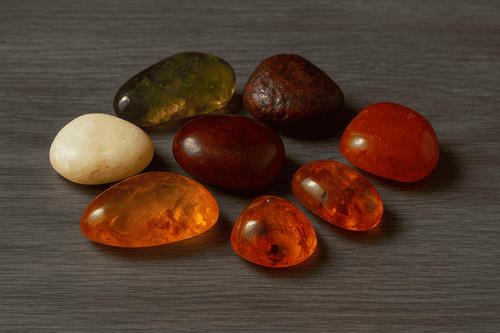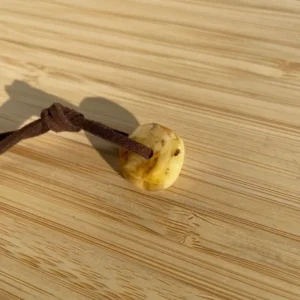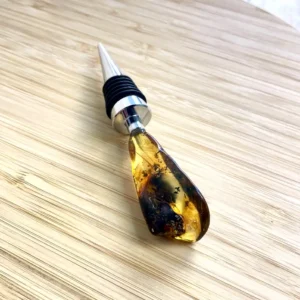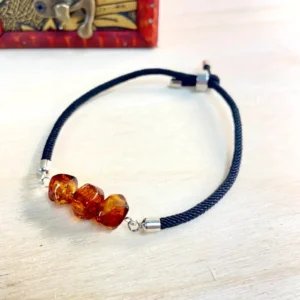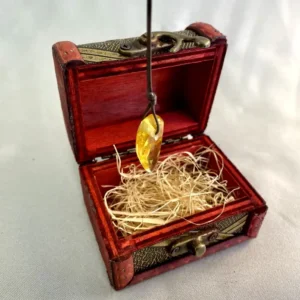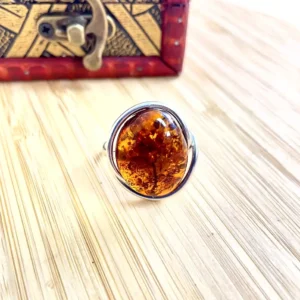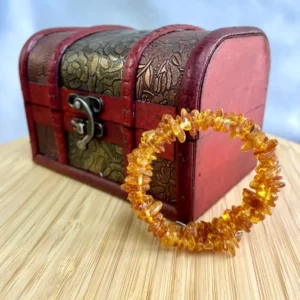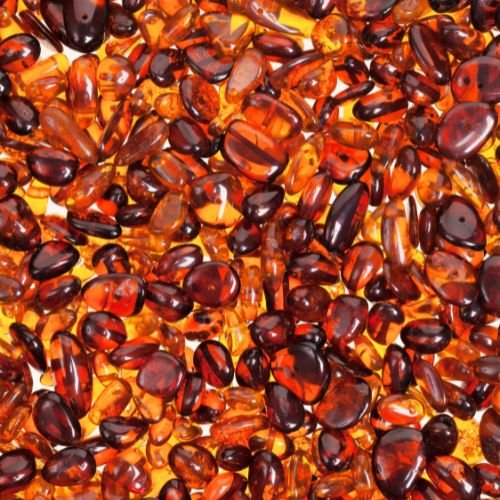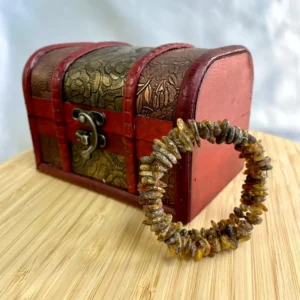Among the world’s natural gemstones, amber stands apart – not a mineral born of pressure and heat, but a fossilized resin, carrying light and life from tens of millions of years ago.
Across continents, amber has been discovered in many forms and colors, each shaped by unique trees, climates, and epochs.
Yet one question often arises: how many types of amber exist, and what makes Baltic amber so special?
This article explores the main types of amber, their geological origins, age, color range, and the key differences that distinguish Baltic amber from all others. These differences also influence the beauty and value of Baltic amber jewelry – bracelets, necklaces, and rings admired for their warm, natural glow.
What Defines a Type of Amber?
Before classifying amber types, it’s important to understand what determines those categories. Scientists and jewelers classify amber by origin, chemical composition, and age, not by color alone.
A “type of amber” refers to the geological and botanical source of the resin – where and when it formed, and which tree species produced it. Amber from one region may be chemically distinct from another even if they look similar.
Three main classification criteria:
- Geological Age: How long ago the resin fossilized — from a few million to nearly 100 million years.
- Geographical Origin: Where the amber was found — Baltic region, Dominican Republic, Burma, Mexico, etc.
- Chemical Composition: The specific acids, oils, and organic compounds it contains — notably succinic acid, which is abundant in Baltic amber.
With these factors in mind, we can explore the most recognized types of amber worldwide.
Baltic Amber (Succinite)
Overview
Baltic amber is the most famous, abundant, and historically significant amber on Earth. It originates from the Baltic Sea region — mainly Lithuania, Latvia, Poland, and Russia’s Kaliningrad area.
Formed 44–49 million years ago during the Eocene epoch, Baltic amber is prized for its purity, durability, and its remarkable preservation of ancient inclusions such as insects, plants, and microscopic air bubbles.
Key Traits
- Scientific name: Succinite
- Age: ~44 million years
- Chemical hallmark: Contains 3–8% succinic acid
- Colors: Honey, cognac, butterscotch (royal), cherry, red, white, and dark brown
- Transparency: Opaque to crystal clear
- Locations: Found in sea deposits (washed ashore after storms) or mined from blue clay layers in Kaliningrad
Distinguishing Features
Baltic amber is unique for its chemical stability and rich spectrum of natural colors. Its succinic acid content provides durability and a distinct infrared signature used by scientists to authenticate genuine amber.
It is the primary material for Baltic amber jewelry – necklaces, bracelets, and rings – forming the foundation of Europe’s amber craftsmanship.
Why Baltic Amber Stands Apart
- Largest known amber deposits worldwide.
- Contains more than 200 fossilized plant and animal species.
- Often used as the standard to which all other amber types are compared.
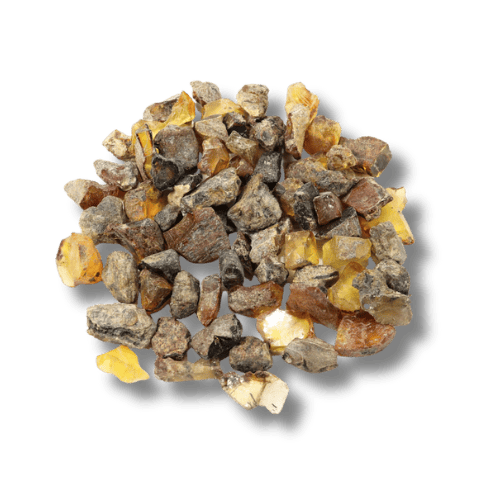
Dominican Amber
Overview
Found in the Dominican Republic, this Caribbean amber is geologically younger and visually more transparent than Baltic amber. It formed from the resin of extinct Hymenaea trees, a tropical legume family.
Key Traits
- Age: ~15–20 million years (Miocene epoch)
- Chemical structure: Lacks succinic acid; more oxygen-rich
- Colors: Light yellow to rich cognac, and rare blue or green varieties
- Transparency: Extremely clear – prized for flawless inclusions
- Origin: Hispaniola (Dominican Republic)
Distinguishing Features
Dominican amber is famous for its optical clarity and fluorescent blue hue under sunlight or UV light – caused by specific molecular compounds in the resin.
Unlike Baltic amber, Dominican amber formed in a tropical environment, preserving ants, mosquitoes, and plant species from humid forests.
Jewelry Use
Because of its clarity and vivid tones, Dominican amber is often cut into cabochons or faceted for contemporary jewelry styles. It’s softer than Baltic amber, requiring gentler handling during crafting.
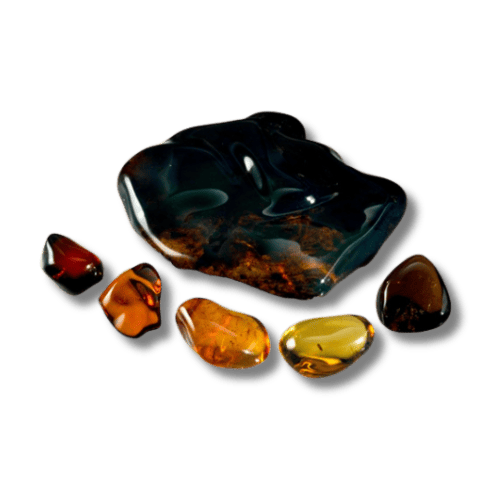
Burmese Amber (Myanmar Amber or Burmite)
Overview
Burmese amber (Burmite) is the oldest commercially known amber, dating back to the Cretaceous period (≈95–99 million years ago). Found mainly in northern Myanmar (Burma), it provides a window into the age of dinosaurs.
Key Traits
- Age: ~99 million years (Cretaceous)
- Color: Deep red, orange, brown; sometimes darker hues
- Transparency: Translucent to opaque
- Unique inclusions: Ancient insects, lizards, feathers, and plant fragments
Distinguishing Features
This amber type is primarily studied by paleontologists because of its dinosaur-era inclusions – some of the oldest and most scientifically valuable in the world.
Unlike Baltic amber, Burmese amber is harder and denser, requiring specialized tools for cutting. It lacks succinic acid but maintains exceptional preservation due to its age and resin chemistry.
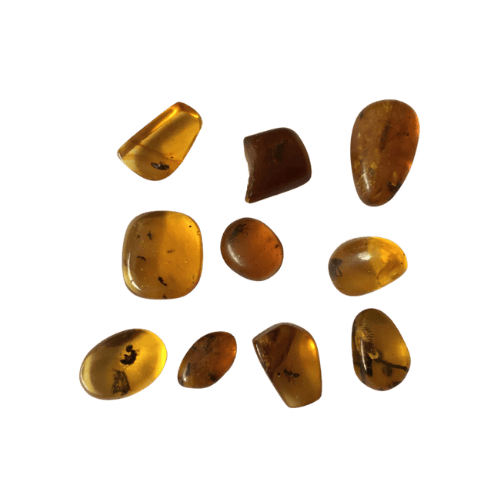
Mexican Amber
Overview
Mexican amber, mainly from Chiapas, is geologically related to Dominican amber – both derived from Hymenaea trees. However, Mexican amber tends to display darker, more reddish-brown tones.
Key Traits
- Age: ~22–30 million years.
- Color: Honey, orange, cognac, and deep red hues.
- Transparency: High to medium; some pieces fluoresce green or blue.
- Origin: Chiapas Highlands, southern Mexico.
Distinguishing Features
Mexican amber is known for its warm glow and fluorescence under UV light. It is harder than Dominican amber but softer than Baltic amber. It often contains inclusions of tropical insects and flowers.
Jewelry Use
Jewelry artisans appreciate its deep natural colors for statement amber necklaces and bracelets.
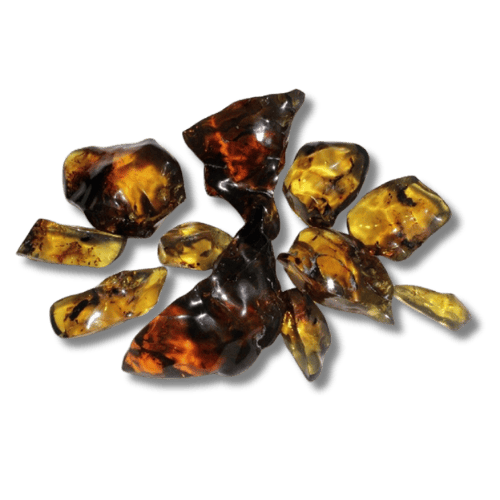
Romanian Amber (Rovno and Carpathian Amber)
Overview
Rovno amber, found in Ukraine and Romania, is geologically close to Baltic amber and nearly as old. It formed in the same Eocene forest ecosystem that stretched across northern Europe.
Key Traits
- Age: ~37–40 million years.
- Color: Yellow to golden brown.
- Chemical composition: Similar to Baltic succinite but with minor differences in resin acids.
Distinguishing Features
Rovno amber often contains similar inclusions to Baltic amber — Eocene insects and plants — leading scientists to classify it as a close relative. However, its deposits are smaller and less commercially mined.
Jewelry Use
Because of its similar appearance, Rovno amber is sometimes used interchangeably with Baltic amber in jewelry, though collectors note subtle differences in tone and density.
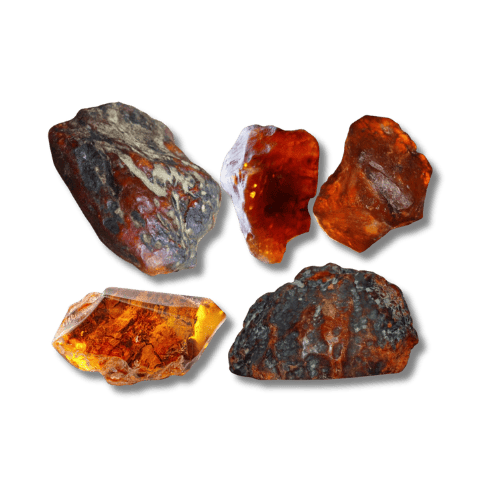
Sicilian Amber (Simetite)
Overview
Sicilian amber, or Simetite, is found around the Simeto River in Sicily. It formed in volcanic sediment during the Miocene epoch.
Key Traits
- Age: ~20 million years.
- Color: Bright yellow to orange-red, often with a glass-like luster.
- Origin: Eastern Sicily, Italy.
Distinguishing Features
Simetite’s volcanic environment created amber with unique physical properties — greater hardness and a slightly refractive surface. It is rare, highly valued by collectors, and often carved into intricate ornaments rather than mass jewelry.

Canadian Amber (Cedar Lake Amber)
Overview
Discovered in Manitoba, Canada, this amber dates to the Late Cretaceous period. It is one of the few North American ambers with significant scientific study.
Key Traits
- Age: ~78–79 million years.
- Color: Brownish-yellow, often opaque.
- Origin: Cedar Lake region, Manitoba.
Distinguishing Features
Canadian amber is rich in fossilized plant material and unique Cretaceous insects, making it valuable to paleontologists. It’s not commonly used in jewelry due to its rarity and brittle nature.
Lebanese Amber
Overview
One of the oldest ambers in existence, Lebanese amber dates back to the Early Cretaceous period (~130 million years old). Found in several mountainous regions of Lebanon, it’s primarily a scientific treasure rather than a gem material.
Key Traits
- Age: ~125–130 million years.
- Color: Orange to brown.
- Transparency: Often opaque with dense inclusions.
- Significance: Contains early insect and plant fossils crucial to evolutionary studies.
Distinguishing Features
Lebanese amber’s extreme age and geological conditions make it darker and more brittle. It’s rarely suitable for jewelry crafting but invaluable for understanding ancient ecosystems.
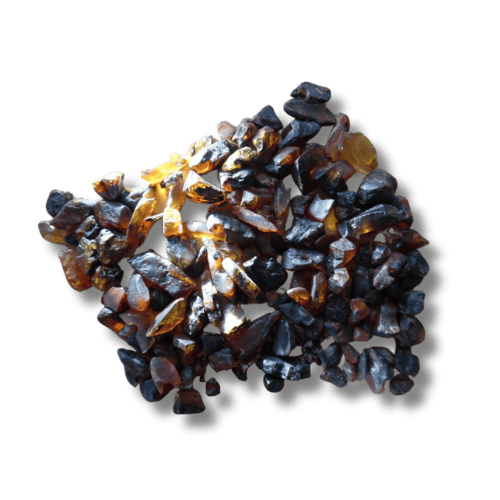
Comparing the Main Types of Amber
| Amber Type | Age (Million Years) | Region | Color Range | Chemical Signature | Typical Use |
|---|---|---|---|---|---|
| Baltic Amber | 44–49 | Northern Europe | Honey, cognac, butterscotch, cherry | Rich in succinic acid | Jewelry, scientific study |
| Dominican Amber | 15–20 | Caribbean | Yellow, blue, green | Lacks succinic acid | Transparent jewelry |
| Burmese Amber | 95–99 | Myanmar | Red, orange, brown | Cretaceous fossil resin | Paleontology |
| Mexican Amber | 22–30 | Chiapas, Mexico | Red, cognac, orange | Similar to Dominican | Jewelry |
| Rovno/Romanian Amber | 37–40 | Eastern Europe | Yellow-brown | Similar to Baltic | Collectible |
| Sicilian Amber | 20 | Italy | Orange, red | Volcanic influence | Decorative pieces |
| Canadian Amber | 78 | Manitoba | Brownish yellow | Fossil-rich | Scientific study |
| Lebanese Amber | 125–130 | Middle East | Brown, orange | Very ancient | Paleontology only |
Key Differences Between Baltic Amber and Other Types
Age and Origin:
Baltic amber formed ~44 million years ago in temperate Eocene forests; most others formed either earlier (Burmese, Lebanese) or later (Dominican, Mexican) in tropical climates.
Chemical Composition:
Baltic amber’s succinic acid content (3–8%) makes it unique — hence the scientific name succinite.
Color Range:
Baltic amber displays the widest natural color palette — from white to dark red — without artificial enhancement.
Inclusions:
While many ambers contain fossils, Baltic amber inclusions are the most diverse and best preserved from Eocene Europe.
Jewelry Use:
Because of its stability, abundance, and workability, Baltic amber dominates global amber jewelry production — from necklaces and bracelets to rings.
Scientific Value:
Burmese and Lebanese ambers hold the oldest biological inclusions, but Baltic amber remains the richest in quantity and variety for paleontological research.
Why Baltic Amber Is the Most Valued Type
Despite the beauty of other ambers, Baltic amber stands at the center of both history and commerce for several reasons:
- It’s the largest deposit on Earth, ensuring consistent quality and availability.
- It’s chemically stable and polishable, ideal for intricate jewelry.
- It captures a balanced combination of clarity, color diversity, and inclusion richness.
- It symbolizes Europe’s amber heritage, especially along the Amber Road, the ancient trade route that carried Baltic amber to Rome, Greece, and Egypt.
For artisans and collectors alike, Baltic amber jewelry — from bracelets and necklaces to rings — remains the most authentic expression of this golden fossil’s legacy.
Frequently Asked Questions About the Types of Amber
Q1: How many types of amber exist?
There are more than 100 documented amber sources worldwide, but only a few major commercial and scientific types — including Baltic, Dominican, Burmese, Mexican, Sicilian, Canadian, and Lebanese amber.
Q2: Which is the oldest type of amber?
Lebanese amber, dating back over 125 million years, is the oldest known. Burmese amber is also from the dinosaur era (~99 million years).
Q3: Why is Baltic amber the most popular?
Because of its abundance, rich colors, chemical stability, and ease of polishing — making it perfect for Baltic amber jewelry like necklaces and bracelets.
Q4: Does blue amber come from the Baltic Sea?
No. True blue amber comes from the Dominican Republic, not from the Baltic region.
Q5: What determines the color of different types of amber?
Tree species, climate, burial conditions, and mineral interaction all influence amber’s final hue and transparency.
Q6: Are all amber types used in jewelry?
No. Only stable, polishable ambers (Baltic, Dominican, Mexican, Sicilian) are common in jewelry. Older types like Burmese and Lebanese amber are mainly used for scientific study.
Final Thoughts: Many Ambers, One Light
Though there are many types of amber scattered across the globe, each with its age, origin, and character, they all share one essence — sunlight captured in time.
From the dense forests of ancient Europe to the tropics of the Caribbean, amber tells a global story of nature’s artistry. Among them, Baltic amber remains the most enduring symbol — the “Gold of the North,” transformed today into radiant bracelets, elegant necklaces, and timeless rings.
No matter where it was formed, every true piece of amber reminds us of one thing: light never truly fades — it only takes new form in the hands of time.
